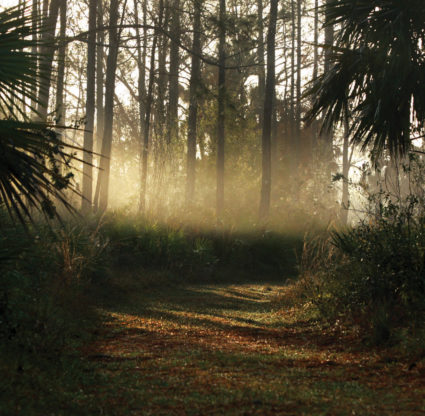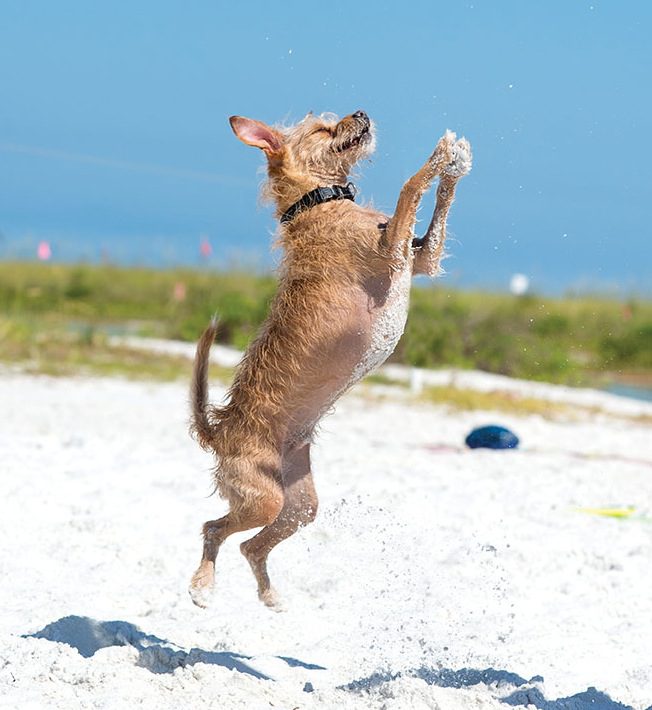My childhood was entwined with trails. Our Cape Cod neighborhood was situated across the street from conservation land, a holly reservation with a dirt road leading to a pond and countless paths snaking into the woods. My brothers and I generally favored one to the right of the road, the hilly one that felt furthest from civilization. In late summer, though, we headed straight to the sunny passes where wild grapes grew, clutching empty bags and anticipating homemade jelly.
For family vacations, we drove north, to the White Mountains of New Hampshire or the Green Mountains of Vermont. We kids always picked the steepest and windiest of trails for the mysteries that might lie around the corner or beyond the rim, and for the panoramic reward at the top. Those still are the trails I choose whenever I venture into territories with terrain.
Florida hiking is not the same. The paths are too flat, too wide, and, often, too short and civilized for the feeling of adventure I long for in the woods. I wanted to round a bend and see a valley; I wanted to scale rocks and hop brooks; I wanted the satisfaction of a summit.
But as my reporting more recently has taken me into Florida’s wilderness, I realize that I hadn’t come to love our region’s hiking because I didn’t understand the land. Northern hiking is brash—the level and terrain changes unmistakable, the seasonal shifts stark, the flora and fauna easy to spot because of the trees’ relative sparsity. Hiking in Southwest Florida is all about subtleties—elevation measured in inches rather than feet, seasons nuanced rather than overt; plant life so abundant that one must stop and peer at detail lest its density blur into a hazy green curtain.
I wanted to learn from experienced guides. And so, one February morning finds me at the head of the CREW Marsh Trails with volunteer naturalist Janet Bunch and CREW communications strategist Anne Reed (no relation to the writer). My friend, photojournalist Stephen Hayford, joins us, too, to document our finds.
Anne, a Michigan transplant, relates to my plight. “It’s hard to get outside in Southwest Florida. This seems like an oxymoron—that’s why people come here, right?” she says. But if you’re not a beach person, she continues, there’s only so much sand you can take; if your idea of romping doesn’t include boardwalk or pavement, you’ve got to do a little research to find the trailheads (see sidebar for suggestions).
I’d never visited CREW, but I knew I’d found the right place. In just minutes, we’d lost sight of the parking lot, the sound of the traffic and the sense of ever-racing time.
Janet, the naturalist, is a 5-foot-tall spitfire of a woman who eschews the banality of her planned community in favor of escapades in the woods.
“Just be still and look,” she instructs, and following her own guidance, stops to peer at a perfectly woven spider web. It’s like the queen’s jewelry box tipped over, she says, the dewdrops sparkling like diamonds. “Look at all of the spider webs in here. It’s an embarrassment of riches.”
I’m not particularly good at being still, but I would quickly learn that the secret to appreciating a Southwest Florida hike is to walk more slowly, stop more frequently and observe more like a child, fresh-eyed and imaginative.
We stop to examine a swath of land recently burned as part of CREW’s forestry management. I love the imagery of this scene: death and renewal, tender green sprouts emerging from charcoal-colored ash. In a few more weeks, Anne anticipates, the rain lilies—joyful, pastel-colored flowers—will bloom; they generally appear six weeks after a burn.
The path veers west. Palmettos flank both sides, songbirds chirp overhead, and we feel the sun drying the dew and warming our cheeks—until Anne abruptly alerts us to a shift.
“Did you just feel the temperature change?” she asks. I’d been too busy chatting to notice, but I stop to consider. Yes, it had dropped; just slightly, like refrigerated air lingering after the door is shut. We’d crossed a threshold a few yards back, Anne explains, from pinewood flat to oak hammock. The vegetation had changed, and the soil, too, a little more compact and less sandy. “Where we were before was higher and drier,” Anne says.
In Florida, inches matter.
We come to a fork in the trail, where my guides identify the state tree, the sabal palm, and the state wildflower, the coreopsis, growing side-by-side. Janet gently twists the yellow bloom to show its underside: “It’s just as lovely on the back,” she says, pointing to burnt orange highlights.
Anne spots a nearby toothpetal orchid, a terrestrial plant humbler than its hothouse cousins and without the mystery of the aerial ghost variety found at nearby Corkscrew Swamp Sanctuary. This plant was waning, but Anne says she “just about lost her mind” the first time she stumbled upon a patch of them in bloom. She was new on the job then, and her superiors halted her from posting photos that would give away the flowers’ location. Even this little ground-dweller might catch the eye of a poacher.
In this same spot, we examine the “boots” of the cabbage palms, teeming with life. Janet looks up and notices dried, spindly branches and seedpods overhead—“architecturally lovely,” she declares, though too fragile for a dried flower arrangement.
“You have to look up and down and sideways,” she reminds us.
This trail leads to an expansive 5,000-acre marsh. We scramble up to a lookout platform and take in the view. To our right, Janet points out a red maple, a species so adaptable that it thrives in Vermont’s cold as well as Florida’s heat. I delight in this arboreal bridge between my childhood hikes and this adult one. Straight ahead is a vast tree line looming over the grasslands—“Florida mountains,” Anne calls them. That’s Corkscrew Swamp Sanctuary, preserved since the 1800s. The CREW land, in contrast, had been logged, and its hardwoods are much younger.
We trek onward, over a boardwalk built to keep feet dry and limbs protected from the saw grass. “Walking through this is like a zillion papercuts,” Janet says. “You itch for weeks. This was Mother Nature on a really snit day.”
“But it’s a great filter,” Anne notes. Janet agrees.
I often marvel at how dense Florida’s foliage grows, but I don’t ever stick my head into the brush and examine one plant at a time. Janet does. In our hours together, she identifies a bay leaf stalk; plucks the tip of a lacy dog fennel plant (to me, it smells like dill; to Stephen, citrus); tears the leaf of a Brazilian pepper to release its biting odor; points out a willow, the host for a “zillion” kinds of butterflies and the originator of aspirin.
We spot a shriveled “resurrection fern” along an oak branch. It’ll spring back to life, verdant and lush, as soon as the rains come, Anne explains. We see thistle, which to me looks spiky and menacing until it produces its feathery, lavender-colored tufts.
Janet wears binoculars around her neck. She doesn’t use them, and she doesn’t need to—she’s trained herself to see the minuscule with naked eye. She and Anne point out slender claw marks carved into the boardwalk railing, and tiny holes drilled in concentric circles by foraging woodpeckers. Had I been on my own, surely I would have walked right past.
We venture deeper into the woods, toward the pop ash swamp. It’s dry at this time of year, though I imagine how primordial it might look once refilled. The trail narrows, vegetation thins and trees loom tall. Anne calls it her “fairy-tale forest.” Her youngest once asked if the hollowed stump we passed might hold little sprites. Of course, she had responded.
It is magical for me, too, but in a different way. It’s on these tree-shrouded single-file paths that I feel most at ease, most disconnected from our wired world and most reconnected to my girlhood self.
I ask Janet, who lived in Ohio and Connecticut before moving to Southwest Florida 18 years ago, and Anne, still relatively new to the region, what they like best about Florida’s wilderness.
“Mine is sound. I don’t think I’ll ever get tired of hearing the sound of wind through palm trees,” Anne says. “It was something I hadn’t heard growing up—I’m used to harsh sounds with winds. Things creaking and banging and the sound of sleet and ice against my window. … But here, it was spooky at first because it wasn’t a sound I was used to, but now, I’m the first one with my family to hush everybody so we can listen to it.”
“I guess the first thing I noticed was how soft the air was,” Janet says. “You know New England doesn’t have a lot of humidity, so it’s very sharp and clear, especially in the wintertime. Here it’s soft, even in the winter.”
For me, I’ll always be that New England girl at heart, scrambling up hills with my siblings. But I think the Florida wilderness is trying to teach the adult me something. Maybe it’s trying to force my eyes, locked on computer screens, to look up and down and sideways. Maybe it’s reminding me to stop and take in little details—a woodpecker’s puncture, a spider’s web, an inch rise in elevation. Maybe it’s inviting me to consider more carefully the laws that govern this land—the cycles of fire and rain and how our human meddling disturbs them.
Mostly, though, I’m just grateful to have discovered a hiking spot that’s a little more rugged, a little less controlled and a whole lot more of an escape.





